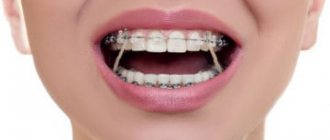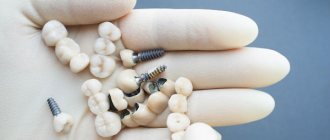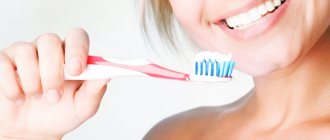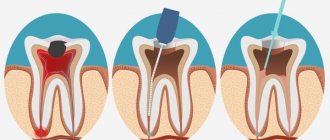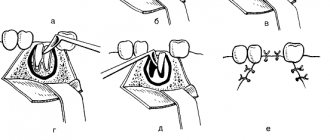18.06.2018
1777
Sign up for a free consultation:
- 1 First symptoms
- 2 Causes of blood and inflammation
- 3 How to detect inflammation?
- 4 Treatment methods
- 5 Prevention
Complaints about bleeding and inflammation of the gums are a common reason for patients to visit the dental office. And its essence does not always lie in injuries from a hard toothbrush. Blood from under a denture may appear due to wearing it for a long time or due to the onset of inflammation. Even if the patient meticulously and carefully takes care of the oral cavity, this cannot provide a 100% guarantee against the onset of tooth decay. This is influenced by a large number of factors that do not always depend on the person.
Causes
The appearance of bloody discharge from under an installed crown can be a symptom of dental diseases, or occur as a result of a medical error after prosthetics.
In addition, the clinical picture with the appearance of this sign can be formed due to pathological processes in the internal organs.
Dental pathologies that cause a taste of blood in the mouth:
- Gingivitis. Basically, the disease manifests itself as a consequence of insufficient oral care. In this case, additional symptoms of bad breath, pain and loosening of the teeth occur.
- Periodontitis. The disease develops if gingivitis therapy has not been carried out in full. In this case, the symptoms of pain, purulent and bloody discharge become pronounced.
- Stomatitis. Most often, fungal pathogens play the main role in pathogenesis. Its development is accompanied not only by bleeding under the prosthesis. The oral mucosa begins to become covered with erosions and ulcers with a burning sensation and pain.
Medical errors that cause bloody discharge from under orthopedic structures.
| Number in order | Cause | Short description |
| 1 | Large gap between the structure and the dental unit | The entry of food particles along with saliva into the gap causes fermentation. Subsequently, it develops into a process of inflammation. |
| 2 | Traumatization by the sharp edge of the prosthesis | The crown part is installed out of size (has an elevation in relation to adjacent incisors or molars). Under the influence of load, the sharp edge will constantly injure the gum, compromising its integrity. |
| 3 | Unprepared dental canal | Before installing an orthopedic product, a pulp devitalization procedure must be performed. If such manipulation was not carried out, or was performed incorrectly, then the chance of developing bacterial inflammation increases significantly. |
| 4 | Depressurization of the structure | In this case, an infection gets under the prosthesis. This situation occurs due to improper installation of the orthopedic product, or due to the use of low-quality materials. |
| 5 | Installation of an orthopedic product on a tooth to be removed | An attempt to save a tooth by putting a crown on it in most cases cannot stop the decay of bone tissue. The putrefactive process will accelerate destruction with the manifestation of negative symptoms. |
Also, bleeding from under the orthopedic structure can occur in the following situations:
- in advanced forms of diabetes mellitus;
- when diseases affecting blood clotting occur;
- with a deficiency of vitamins and microelements in the diet;
- in case of hormonal imbalance due to disruption of the endocrine system;
- response to the use of certain medications.
The reasons for the appearance of a noticeable gap between the crown and the gum and ways to eliminate the defect.
Visit here to learn more about dental sockets.
At this address https://www.vash-dentist.ru/protezirovanie/nesemnyie-p/koronki-np/restavratsii-keramokompozitnyih.html you will find all the most important things about ceramic composite crowns.
When bleeding comes from a tooth - what to do?
Most often, blood flows from the gums and teeth due to improper actions of the patient after manipulations in the dental office. So, once again disturbing the wound with your tongue, you can tear off the crust and cause new bleeding. In such a situation, stopping bleeding from the tooth comes down to the need to prevent new situations, as a result of which the crust will fall off again, until the wound heals.
We suggest you familiarize yourself with periodontal disease treatment at home with hydrogen peroxide
If bleeding continues for a long time, then you can apply a cotton swab dipped in hydrogen peroxide to the wound site. In this case, the bleeding should stop within 15-30 minutes, otherwise you will need to seek medical help.
Hydrogen peroxide for bleeding
Sometimes, dental bleeding can occur against the background of oral diseases, but in such cases it is necessary to treat not the consequence (the appearance of blood), but the cause - the disease. The victim’s actions to relieve pain can only worsen the situation, because oral diseases (flux, periodontitis and others) do not go away on their own and require qualified help. And the sooner it is received, the better, because in this case medical intervention will be minimal.
If a person is diagnosed with blood diseases or other diseases, against the background of which there is a blood clotting disorder, then the doctor should be puzzled by the question of how to stop bleeding from a tooth when receiving this information from the patient. Unfortunately, bleeding from a tooth in this case can only be stopped with the help of medications prescribed by a doctor.
Typically, tooth extraction is a last resort treatment. Most often, a dentist prescribes diagnostics, treatment and other measures to preserve a person’s beautiful smile. Moreover, modern treatment methods have become so widespread and expanded their scope that it is not very difficult to preserve teeth in their entirety. But there are situations when tooth extraction is simply necessary, otherwise the problem may spread even more.
There are many options for removal, in particular we are talking about the technology itself and the location of the tooth. There are situations when stopping the bleeding after tooth extraction is much more difficult than carrying out the extraction itself.
Additional symptoms
After installation of an orthopedic structure, sometimes a slight swelling and pain occurs, and ichor may come out from under the prosthesis - this is the norm.
But if these manifestations do not go away within three days, this is a deviation from the norm, and a visit to the dentist cannot be avoided.
Bloody discharge after the installation of orthopedic structures is part of the clinical picture of most problematic situations in dentistry, and therefore occurs simultaneously with other signs.
Most often, their appearance is associated with the development of the following symptoms:
- Painful sensations. Permanent injury to the gums when the rules of prosthetics are violated is accompanied by pain (especially when eating). A feeling of discomfort in the form of throbbing pain becomes a consequence of acute inflammation with the possible formation of an abscess.
- Smell of rotting from the mouth . It can occur both due to insufficient hygienic care and due to the formation of a carious cavity under the dental crown.
- Swelling and hyperemia of the soft tissues of the oral cavity. The patient may perceive the hypertrophied gingival surface as a foreign body.
- Deterioration of general condition. Symptoms of intoxication are accompanied by the appearance of anorexia (partial or complete loss of appetite), an increase in body temperature, and a sharp loss of strength.
Diagnostics
To eliminate blood discharge from under the tooth crown, it is necessary to establish the cause of the pathological process. This is due to the fact that a set of therapeutic measures should be aimed at treating the underlying disease (the cause must be treated, not the consequences).
Initially, the dentist conducts an external examination and listens to complaints from the patient.
A visual examination of the oral cavity takes place, paying attention to the following changes:
- the state of the degree of redness of the gingival surface is assessed;
- tissue swelling is checked by pressing dental instruments on the gums (if the result is positive, an imprint appears);
- the appearance of a hole will indicate a fistula;
- the release of purulent contents with bloody ichor will suggest the onset of the inflammatory process.
To make a final diagnosis, the most informative method will be an X-ray examination. With its help, the dentist will assess the condition of the root system. In addition, an x-ray will help exclude the development of any type of compaction (cyst or granuloma).
Learn more about the reasons for the appearance of blood from under the crown of a tooth and tactics for getting rid of the symptom.
Patients often come to the dentist with complaints about blood appearing from under the crown.
The occurrence of this phenomenon is influenced by several reasons, which sometimes do not depend on the person at all. The main thing in such a situation is to correctly identify the provoking factor and eliminate it in a timely manner.
The content of the article:
Treatment
Complex therapy allows you to stop the inflammatory process and get rid of the negative manifestations of the clinical picture.
During treatment, medications and traditional healing recipes are used. Sometimes it becomes necessary to remove the prosthesis and then replace it.
Removing the crown
When bloody discharge is the cause of a medical error due to poor-quality prosthetics, then the development of further inflammation can be prevented only by removing the orthopedic product.
After this, the problem that has arisen is eliminated (the root system, carious cavities are sanitized, or the pathological formation is removed).
After the elimination of negative symptoms, repeated prosthetics are performed. The old structure is not reused, since it is severely deformed when removed.
It should be borne in mind that on the front incisors there is the possibility of retaining the prosthesis. In this case, the canals are cleaned under the crown. In most cases, this technique is used as a temporary measure (when it is not possible to carry out a full restoration complex).
The main factors that provoke an unpleasant odor from under the crown of a tooth and tactics for eliminating the problem.
In this publication we will look at the composition of dental ceramics.
Here https://www.vash-dentist.ru/protezirovanie/nesemnyie-p/oslozhneniy-posle-zubov.html find out what complications may arise after dental prosthetics.
Use of medications
Drug therapy for diseases in the clinical picture of which the main symptom is bleeding from under the crown involves the use of the following medications:
- Antiseptics. They are used for the purpose of rinsing, ridding the oral cavity of the presence of pathogenic microflora. The most commonly used are Furacilin or Hydrogen peroxide, Chlorhexidine or Miramistin.
- Antimicrobial solutions. A positive effect is observed in the case of the use of herbal preparations (Chlorophyllipt, Tantum Verde, Rotocan). It will speed up the regeneration of tissues around the tooth (Cholisal, Metrogyl Denta, Solcoseryl).
- Antibiotics will be the drugs of choice if a bacterial infection is present in the pathogenesis of the disease. Amoxicillin, Doxycycline, Gentamicin or Lincomycin will be effective.
- Antifungal drugs are used to treat candidal stomatitis. Flucostat or Diflucan, Imudon or Mikosist, Pimafucin or Nystatin have positive dynamics.
Traditional medicine recipe
As additional therapy, it is recommended to use pharmacy and homemade infusions and decoctions.
For daily rinsing procedures, it is recommended to use a decoction of chamomile, calendula, sage or oak bark inflorescences. Applications with freshly squeezed aloe juice will help relieve inflammation.
You need to know that any type of medicinal plant is not recommended for use at the initial stage of the disease (without medical prescription). This may mask the clinical picture, causing difficulties in making a diagnosis.
The video provides additional information on the topic of the article.
Need a dentist's opinion.
I installed a crown.
A long time ago, about 7 months ago. Bleeds when brushing teeth every day. At first I thought it was natural after prosthetics. Then I didn’t pay attention. Then I spent a long time trying to figure out where the bleeding was coming from - I found out that it was coming from under the crown. Then I went to the doctor who diagnosed it. In short, the doctor said that you need to brush your teeth harder and that this is normal. Is it normal to bleed every day? Should I go to another dentist? Belarus, then? I was just about to go get prosthetics, your doctors were very praised. Now I'll think about it.
quote: Originally posted by hollowpoint: Go to another dentist
But what do you think, if blood is constantly coming from somewhere, is it normal? Go do something else. It all depends on the correct preparation of the tooth for the crown, and the natural technical work
So, well, since the Prosthetist does not unsubscribe, I will unsubscribe.
First of all, think for yourself, 7 months of bleeding, could this even be the norm?
Go to another dentist again.
Secondly, either the granulation has grown there, or it is not from under the crown, but from the gums.
Is the tooth pulpless? may be a consequence of improper depulpation.
In general, to another doctor. The crown may also have to be redone.
quote: Originally posted by TEq: Is the tooth pulpless? may be a consequence of improper depulpation.
Sit down! 2! They told me that they don’t teach anything now, but I didn’t think that in reality everything is so crap in the institutes
quote: Sit down! 2!
Well, explain.
The teacher just told me about granulation and depulpation.
proliferation of granulations, yes. The trace of the preparation is not into the ledge, but under the gum. When fixing the roots, the edges do not fit into the joint with the stump, but hang like a hat and, naturally, with the physiological “mobility” of the gingival edge, they injure it in the same way as hard dental deposits. Incorrect depulpation does not It happens that there is incomplete and loose obturation of the root canals of the tooth, which leads to infection of the apical bone tissue and, as a result, tooth loss, which has nothing to do with bleeding. That's it in a nutshell
quote: There is no such thing as incorrect pulp removal; there is incomplete and loose obturation of the root canals of the tooth,
I meant that the decay of the pulp was not completely removed. and then the canal was filled.
Thanks for the explanation, in detail, now I understand everything.
How about the fact that there was no ledge at all?
In our orthopedics, everyone is sharpened without a ledge. Even under MK.
quote: Originally posted by TEq: How about the fact that there was no ledge at all?
of course it wasn't
quote: Originally posted by TEq:
Thanks for the explanation, in detail, now I understand everything.
Please, contact me if anything happens. (pulp decay does not bleed) Without ledge, without retraction, and in general MK is PORN
Uv. marus, thanks for the clarification!
quote: Originally posted by hollowpoint: I installed a crown. A long time ago, about 7 months ago. Bleeds when brushing teeth every day.
You have to look with your eyes and take an X-ray. Why guess? Most likely as already written. Overhanging edge, cement not removed, etc. What does the crown look like? Metallic color?
quote: Originally posted by Prothesist: You have to look with your eyes and take an X-ray. Why guess? Most likely as already written. Overhanging edge, cement not removed, etc. What does the crown look like? Metallic color?
No, the color is no different from your natural teeth. In general, everything is clear: if the doctor gave a bad job, it needs to be remade by someone else. There is a chance that the new one will be better.
Let's. Otherwise, the tooth will come out from under the crown or along with the crown.
quote: Originally posted by marus: in general MK is PORN
what then is NOT porn.
frameless (all-ceramic) probably
quote: Originally posted by TEq: frameless (all-ceramic) probably
Yes, “Batka” probably has 1 “Tserek” for the whole country.
quote: Originally posted by TEq: frameless (all-ceramic) probably
that's it - “probably”. It is NOT the material that does the work, but the person.
quote: marus
Is it really possible that after the books by Yamamoto and Ubassi one will dare to say that quote: Originally posted by marus: in general MK is PORN
?
Any casting porn The milling cutter and press are ours - will you mill all the KHS caps and beams? There are no complaints, but I’m generally silent about Ni (from which they continue to pour)
quote: Originally posted by ZeroSignal: books by Yamamoto and Ubassi
By the way, did CAD/CAM already exist at that time?
To be honest, after the lectures by Ordzhonikidze and Oransky, I no longer wanted to be an orthopedist. All this cutting out with a bur is not at all for me. brrr. I definitely like surgery. But damn, money. versatility. crap.
quote: Originally posted by marus: Any casting porn
Don't you like cats? You just don’t know how to cook them! (c) quote: Originally posted by marus: The milling cutter and press are our everything
Can you remind me of the percentage of use of milled metal frames in Moscowabad? and in Zamkadye?
quote: can you remind me of the percentage of use of milled metal frames in Moscowabad? and in Zamkadye?
******sk. Lecture on milling.
After 4 hours the lecture ended. Question from the audience: what about stamping and stamping?
quote: Originally posted by ZeroSignal: Can you remind me of the percentage of use of milled metal frames in Moscowabad? and in Zamkadye?
“But I’m not Isidora Duncan” (c) so I make metal-free, I ask the beams to be milled and sent to SAE
quote: Originally posted by marus: by the way, was there already CAD/CAM at that time?
I think that at least one of them was: (stolen from Tyrnet) The method of computer restoration was developed in 1980 by Professor V. Mermann and Dr. M. Brandestini, at the University of Zurich, where the first patients were treated in 1985 After acquiring a license for the CEREC device, Siemens AG (now Sirona Dental System GmbH) held an international presentation in 1988 of the CEREC 1 device, which made it possible to produce inlays. With the development of software in 1990, it became possible to produce onlay inlays, and in 1994, simple veneers for anterior teeth. In the same year, the CEREC 2 device was developed, which produces inlays, onlays and veneers, and since 1998, crowns for lateral and anterior teeth.
Read also: How to strengthen gums if they bleed
The 3rd is already sharpening the bridges, but I’m not talking about this PRETTAU - are you doing? https://www.prettau.ru/
Is PRETTAU a panacea for crooked hands? abs, cerec and zirconzan + hands suit more than (as a patient).
In general, it’s more likely not a question, but a general consultation from the outside, not from those whom I turn to for dental repairs. Background: tooth 6, if I understand correctly, generally the 3rd from the edge. The hole in the middle also began to ache. They drilled it and put a filling. It was fine for a year, then it fell out. They drilled more extensively and hinted that for a certain fee the filling would be of better quality, and not the guano that was there. There was money at that moment, and I had the required amount in my pocket, I agreed. They spent a long time fiddling with the tooth, took it for an x-ray, and they said everything was ok. A month later it began to hurt, but not much, and after another month the inner part of the tooth fell off. The pain stopped, but the shape was “G”, i.e. wall and a filling on top, and there is sourness in the mouth. After some time I came to the dentist, the diagnosis was: removal. After removal, the sour taste became stronger and the reason for its appearance became clear - the hole went all the way to the maxillary sinus, it was possible to move air directly from the mouth to the nose, but the sensations were unpleasant
Actually, the question is that the fillings are symmetrical, and how to avoid a similar case. Chronic sinusitis has been present for many years.
quote: Originally posted by kav13: It was fine for a year, then it fell out.
What city is this in?
Yes, in any case. We are talking about an ordinary clinic, if I understand correctly.
quote: Originally posted by kav13: how to avoid a similar incident.
avoid what?, perforation into the maxillary sinus?
Just a guess for now - the first time it was sealed, it fell out. It fell out, they filled it up, then pulpitis happened when they removed it - either they pierced the bottom of the sinus, or there was a message anyway (in general, such perforation is a completely standard complication in dental surgery), in theory, since the pictures were taken, they could see that you were just such a case.
To prevent fillings from falling out, go to proven places where the quality is high and often expensive. And even then they told us at the master class: “medicine is an inexact science, so you have to pay twice.”
Avoid perforation? This is either your anatomical feature or the surgeon’s mistake. But in general this happens, there is nothing supernatural about it. Did you stitch it in immediately or later?
Prevention
The erroneous belief that crowns do not require special care leads to the development of pathologies that affect both soft and bone tissues of the oral cavity.
To prevent this, during the process of hygienic care you must adhere to the following rules and recommendations:
- Give up the habit of gnawing hard nuts or crackers.
- Choose the right hygienic paste and brush. Use them to cleanse at least twice a day.
- After each meal, rinse the mouth using rinses or dental elixirs (Acepta, Forest Balm, Lockout Sensitive, Mexidol).
- The spaces between the elements of the dentition are cleaned using a special brush or dental floss.
- A good purchase would be an irrigator, the use of which will remove food particles and provide a gentle massage to the gums.
- To have your teeth professionally cleaned, you need to visit the dental office once a year.
Reviews
The majority of the population, faced with such problems, testifies that when a tooth is destroyed under the crown, the prosthesis cannot be preserved.
In addition, sometimes situations arise when a dental unit cannot be treated. You can leave your opinions and comments in this article.
If you find an error, please select a piece of text and press Ctrl+Enter.
Tags dental crowns fixed prosthetics
Did you like the article? stay tuned
Previous article
What to do if your removable dentures are loose?
Next article
How long does it take a patient to get dentures?
